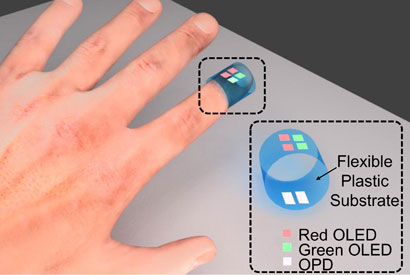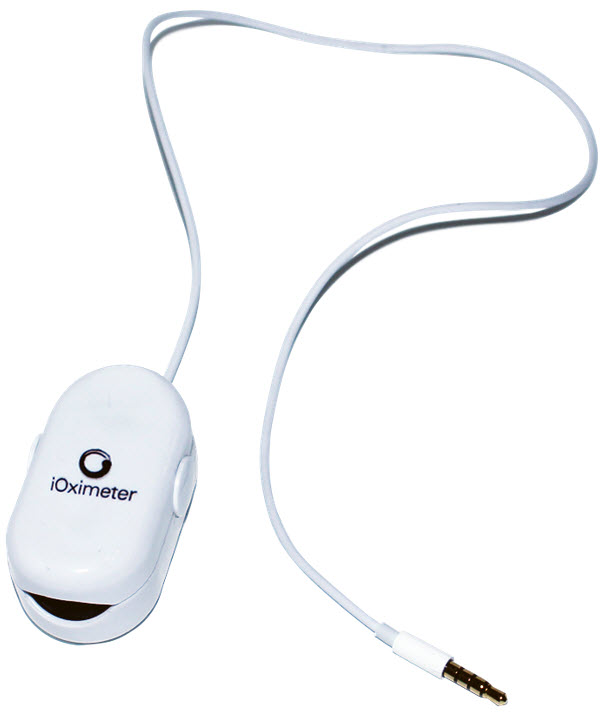A disposable organic oximeter
December 12, 2014

A pulse oximeter sensor composed of all-organic optoelectronics. The red and green organic light-emitting diodes (OLED) are detected by the organic photodiode (OPD). The device measures arterial oxygen saturation and heart rate as accurately as conventional silicon-based pulse oximeters. (Credit: Yasser Khan)
Engineers at UC Berkeley have designed a wearable organic (carbon-based) oximeter (for blood-oxygen levels) device that could ultimately be thin, cheap, and flexible enough to be slapped on like a Band-Aid.
“There are various pulse oximeters already on the market that measure pulse rate and blood-oxygen saturation levels, but those devices use rigid conventional electronics, and they are usually fixed to the fingers or earlobe,” said Ana Arias, an associate professor of electrical engineering and computer sciences and head of the UC Berkeley team.
The engineers found that pulse and oxygen readings with the new prototype were just as accurate as with conventional pulse oximeter, which typically uses light-emitting diodes (LEDs) to send red and infrared light through a fingertip or earlobe.
Sensors detect how much light makes it through to the other side. Bright, oxygen-rich blood absorbs more infrared light, while the darker hues of oxygen-poor blood absorb more red light. The ratio of the two wavelengths reveals how much oxygen is in the blood.

The Kenek Edge (credit: LionsGate Technologies)
For the organic sensors, Arias and her team of graduate students used red and green light. They deposited the green and red organic LEDs and the translucent light detectors onto a flexible piece of plastic that can easily conform to the body.
Arias said hat because the components of conventional oximeters are relatively expensive, healthcare providers will choose to disinfect them if they become contaminated. In contrast, “organic electronics are cheap enough that they are disposable like a Band-Aid after use.”
The Kenek Edge iOS 8 pulse-oximeter app-device, introduced in September, is another low-cost approach. It connects an oximeter sensor to a mobile phone or tablet. This concept might conceivably also work for UCB’s organic oximeter design.
The National Science Foundation and Flextech helped support this research, with was published Wednesday Dec. 10 in Nature Communications.
Abstract of All-organic optoelectronic sensor for pulse oximetry
Pulse oximetry is a ubiquitous non-invasive medical sensing method for measuring pulse rate and arterial blood oxygenation. Conventional pulse oximeters use expensive optoelectronic components that restrict sensing locations to finger tips or ear lobes due to their rigid form and area-scaling complexity. In this work, we report a pulse oximeter sensor based on organic materials, which are compatible with flexible substrates. Green (532 nm) and red (626 nm) organic light-emitting diodes (OLEDs) are used with an organic photodiode (OPD) sensitive at the aforementioned wavelengths. The sensor’s active layers are deposited from solution-processed materials via spin-coating and printing techniques. The all-organic optoelectronic oximeter sensor is interfaced with conventional electronics at 1 kHz and the acquired pulse rate and oxygenation are calibrated and compared with a commercially available oximeter. The organic sensor accurately measures pulse rate and oxygenation with errors of 1% and 2%, respectively.